Saturdays, noon to 1 p.m. ET on WICR 88.7 FM.
Or listen live from anywhere on WICR Online!
Our call-in number during the show: (317) 788-3314

July 14, 2018
Lighthouse heritage and the Eastland maritime tragedy
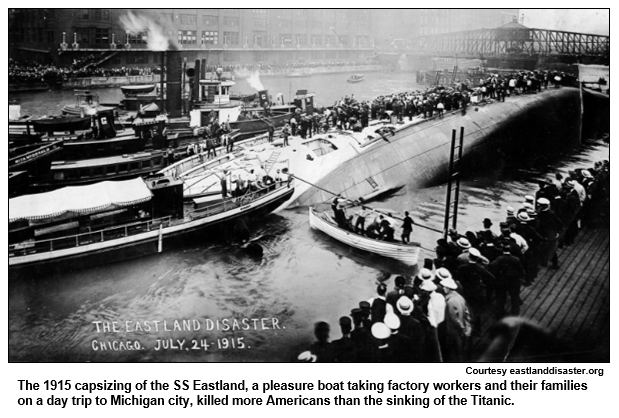
(July 14, 2018 ) About 845 factory workers and their families aboard an excursion ship on a day trip to Michigan City, Ind., for a picnic were killed in a tragedy in July 1915 that's been mostly forgotten - even though more Americans perished that day than during the Titanic shipwreck three years earlier.
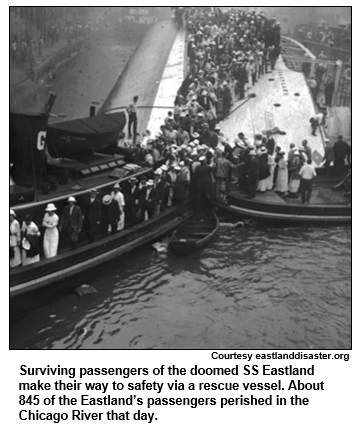
As we explore the Eastland maritime tragedy, we also spotlight the Indiana heritage of lighthouses that were so crucial for navigators on watercraft ranging from small boats to large cruise ships on Lake Michigan.
Jim Retseck, president of the Michigan City Historical Society, which oversees the Old Lighthouse Museum, is Nelson's guest. The museum is located in the former Michigan City Lighthouse built in 1858 that housed a live-in lighthouse keeper until the U.S. Coast Guard took over operations in 1939. According to Jim, the definition of a lighthouse is a building in which the keeper actually resides; contemporary structures on Lake Michigan, the Ohio River and other waterways that people refer to as lighthouses should technically be called "navigational devices," Jim says, because they are unoccupied.

The lighthouse heritage in Michigan City dates to the mid-1830s, when a "postlight" - defined as a lantern on a tall pole - was erected near the site of an initial lighthouse, a whitewashed tower built in 1837 that preceded the 1858 structure. According to the Michigan City Historical Society, the site's beacon "served as a guiding light for Great Lakes sailors for more than 100 years."
A series of anniversary events were set for later in July, including a memorial service July 21 commemorating the 103rd anniversary of the Eastland tragedy. The U.S. Coast Guard intended to place a wreath near the Old Lighthouse Museum, and Patricia Sutton, author of Capsized: The Forgotten Story of the SS Eastland Disaster, was slated to speak. More information on the events is available at the Michigan City Historical Society's website.
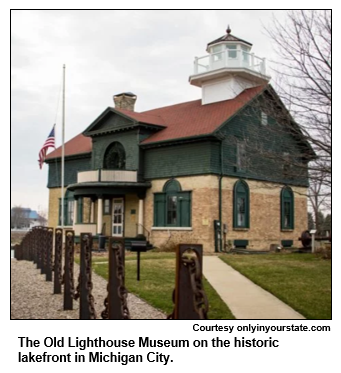
As with the Titanic tragedy, hundreds of women and children were among the fatalities in the Eastland disaster. The excursion to Michigan City was a highly anticipated annual event for Western Electric employees because many of them did not have holidays off work.
Known as the "Speed Queen of the Great Lakes," the Eastland was top-heavy and had a pattern of listing. Later analysis determined that the steamship had inherent design flaws.
Some history facts:
- The original Michigan City lantern tower in the 1830s was fueled with whale oil. Beginning in the 1880s, kerosene was used, according to the Michigan City Historical Society.
- On the fateful day in the Chicago River, the Eastland rolled over in water that was about 20 feet deep. Many of the victims were trapped beneath the overturned ship.
- Our host, Nelson, has a family connection to the Eastland tragedy. His maternal grandfather, a 7-year-old boy in 1915, was supposed to be aboard the ship with his father, a Western Electric worker. They were spared only because they arrived too late to board. In the aftermath of the tragedy, he had the heart-breaking task of helping identify the bodies of his co-workers.
History Mystery

Several weeks after the SS Eastland overturned in July 1915, the ship was recovered from the Chicago River and eventually recommissioned by the U.S. Navy. A Hoosier who later became nationally famous spent one summer aboard the ship - renamed the USS Wilmette - while he was in the Navy Reserves and attending Indiana University.
The Indiana native became well-known during the 1930s as a syndicated columnist - or "roving human-interest columnist" - for the Scripps-Howard newspaper chain. Sometimes filing stories as "The Hoosier Vagabond," he reported everywhere from Chesapeake Bay in Maryland to Good News Bay in Alaska.
His greatest claim to fame, though, came as a war correspondent during World War II. He won a Pulitzer Prize for his stories and columns during the war.
Question: Who was the Hoosier journalist who spent a summer on the former SS Eastland?
The prize is two tickets to 1859 Balloon Voyage, courtesy of Conner Prairie Interactive History Park a gift certificate to Story Inn in Brown County, courtesy of Story Inn, and two tickets to the Indiana History Center, courtesy of the Indiana Historical Society.
Roadtrip: Chesterton and the Dunes
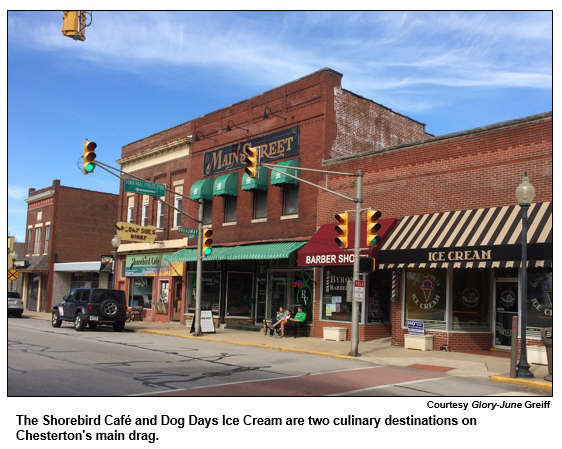
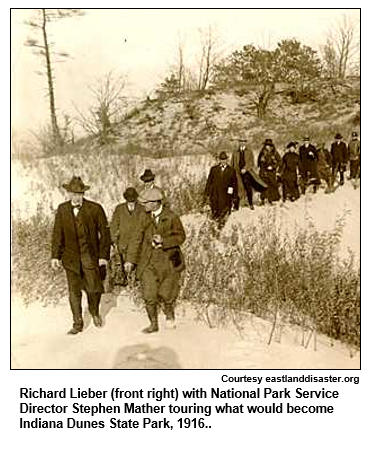
Chesterton is a charming historic town, much of which is listed in the National Register. Finding a restaurant is not a problem, but choosing one may be! Glory-June recommends Ivy's Bohemia House for a fun and varied menu, suitable for all tastes. "What atmosphere!" she says.
For more casual dining try the old-style Shorebird Cafe (aka Peggy Sue's Diner), and for dessert or a treat Glory-June recommends Dog Days Ice Cream. Both are on are the main north-south street in Chesterton, Calumet.
And though there's nothing like a beach town in summer, Glory-June tells us she prefers to visit Chesterton in the spring and fall, when the weather tends to be more pleasant and the crowds smaller.
And those who love poetry can hear Glory-June doing a poetry performance at Indiana Dunes State Park on Sept, 22 at 6:30 p.m. Central Daylight Time as a part of an Arts in the Parks event.
Prizes solicited for History Mystery contest
If your business or organization would like to contribute prizes for our History Mystery contest, we would love to have them! Ideally they fit in a standard mailing envelope, such as coupons or vouchers.
Your organization gets a mention on the air by Nelson, as well as a link to your website on our newsletter and website! If interested, contact producer Molly Head at molly@hoosierhistorylive.org.
Nelson Price, host and historian
Molly Head, producer/project manager, (317) 927-9101
Michael Armbruster, associate producer
Cheryl Lamb, administrative manager
Richard Sullivan, senior tech consultant
Pam Fraizer, graphic designer
Garry Chilluffo, special events consultant
Please tell our sponsors that you appreciate their support!

 Acknowledgments to Monomedia, Visit Indy, WICR-FM, Fraizer Designs, Heritage Photo & Research Services, Henri Pensis, Chris Shoulders, Aaron Duvall, and many other individuals and organizations. We are an independently produced program and are self-supporting through organizational sponsorship, and by individual contribution at the yellow button on our newsletter or website. For organizational sponsorship, which includes logos, links, and credits in the show, contact Molly Head at (317) 927-9101 or email her at molly@hoosierhistorylive.org. And any of our podcasts can be sponsored for a nominal fee.
Acknowledgments to Monomedia, Visit Indy, WICR-FM, Fraizer Designs, Heritage Photo & Research Services, Henri Pensis, Chris Shoulders, Aaron Duvall, and many other individuals and organizations. We are an independently produced program and are self-supporting through organizational sponsorship, and by individual contribution at the yellow button on our newsletter or website. For organizational sponsorship, which includes logos, links, and credits in the show, contact Molly Head at (317) 927-9101 or email her at molly@hoosierhistorylive.org. And any of our podcasts can be sponsored for a nominal fee.
Thank you!
We'd like to thank the following recent, new and renewal contributors whose donations help make this show possible!
- Daniel Craig
- In memory of Elizabeth Meyer Strain Gunn by Roz Wolen
- Margaret Smith
- Stacia Gorge
- Robin Jarrett
July 21, 2018 - Upcoming
Roadside motels, bygone Americana: Encore presentation
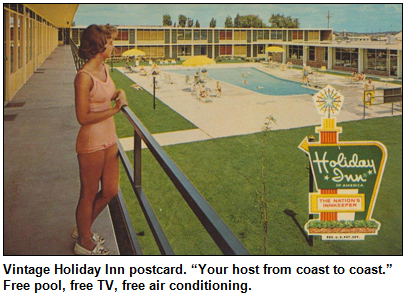 (This show was originally broadcadst on May 30, 2015)
(This show was originally broadcadst on May 30, 2015)
Remember the motels, cabin courts and other lodging spots that were so familiar on pre-interstate highways?
Many bit the dust long ago, but in this show Hoosier History Live explores their heyday - as well as their decline - just as many folks have been hitting the road for vacations. During our show, we even explore still-familiar chains such as Holiday Inn. But our focus is on the bygone style and architecture familiar to motorists from the 1940s through the '70s, rather than the type operated by the international conglomerate today.
Our studio guests include Jeff Kamm, who shared insights about former roadside Holiday Inns in the Indy metro area in this Historic Indianapolis article.
Jeff, a graduate of Purdue's hospitality and tourism management program, worked for 10 years managing various hotels in the Indy area; today, he works in the financial services industry.
Jeff and Nelson are joined by Joan Hostetler, founding director of the Indiana Album, who also collaborated with Nelson on the visual history book Indianapolis Then and Now and related projects; aspects of our heritage that Joan has extensively researched include roadside architecture.
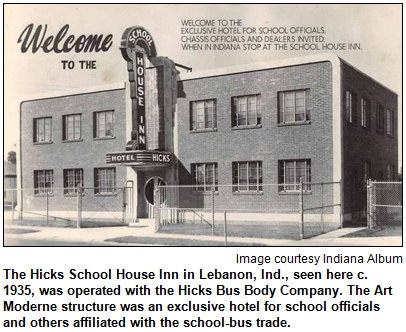 Certainly the design of many roadside motels and hotels was distinctive, such as the orange and blue appearance associated with Howard Johnson Motor Lodge chain. According to our guest Jeff Kamm, the first Howard Johnson Motor Lodge opened in 1954 in Savannah, Ga.
Certainly the design of many roadside motels and hotels was distinctive, such as the orange and blue appearance associated with Howard Johnson Motor Lodge chain. According to our guest Jeff Kamm, the first Howard Johnson Motor Lodge opened in 1954 in Savannah, Ga.
About 30 years before that, towns during the 1920s began establishing free "auto camps" as Americans took to the roads with the boom in car ownership, Jeff notes.
Prior to - and sometimes simultaneously with - the evolution of the roadside motel came lodging spots that consisted of cabins for overnight guests clustered around a check-in office. They were known as tourist cabins or cabin courts.
According to Jeff's research, by 1956 about 500 roadside motels were scattered across Indiana. Along U.S. 40 across Indiana that year, there were 120 of the motels.
Jeff's track record in the hospitality industry includes managing properties in the Marriott and Radisson families of hotels.
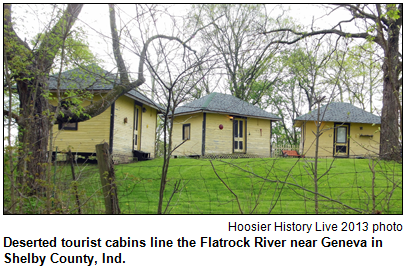 The first Holiday Inn in the Indy area opened in 1960 "across from the main gate of the area's biggest attraction, the Indianapolis Motor Speedway," Jeff writes in his historicindianapolis.com article. The Holiday Inn in Speedway featured the neon green sign that became such a common sight across Indiana and the rest of the country.
The first Holiday Inn in the Indy area opened in 1960 "across from the main gate of the area's biggest attraction, the Indianapolis Motor Speedway," Jeff writes in his historicindianapolis.com article. The Holiday Inn in Speedway featured the neon green sign that became such a common sight across Indiana and the rest of the country.
His article notes that the oversized neon signs and some other once-standard features of Holiday Inns have vanished as the chain evolved.
"Drivers may recently have noticed a pile of rubble on U.S. 31 immediately south of the I-465 interchange," Jeff writes. "This is the last reminder of the Holiday Inn in the Circle City in its traditional incarnation."
In recent years, many former roadside motels across Indiana - particularly those that were locally owned - have been converted into apartments or lodging spots with extended-stay occupancies.
© 2018 Hoosier History Live. All rights reserved.
|





